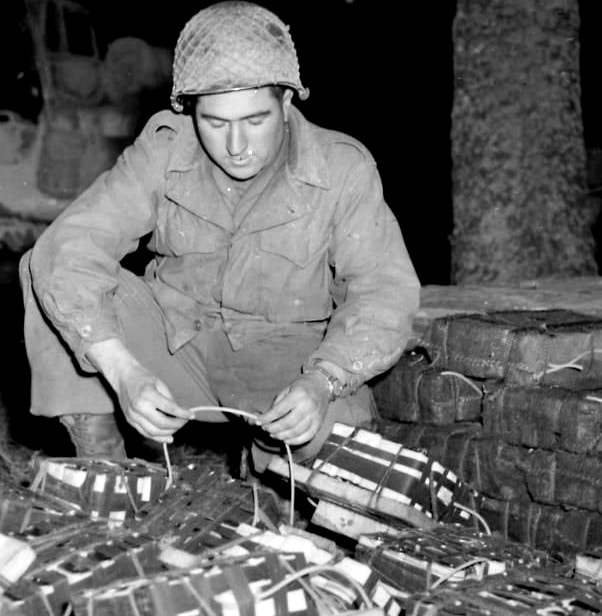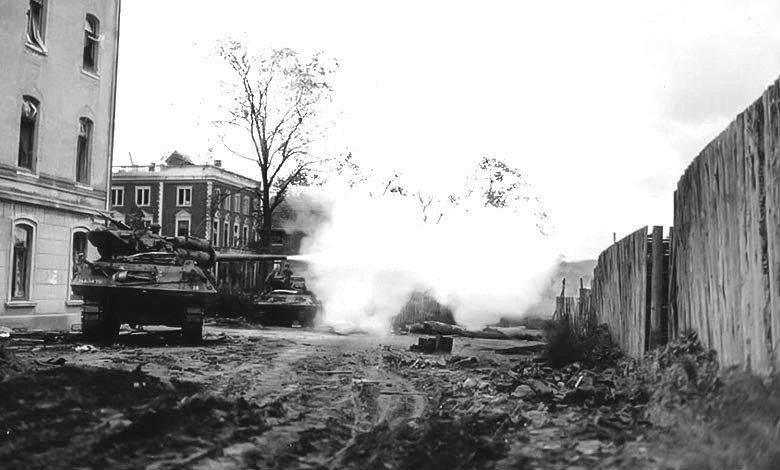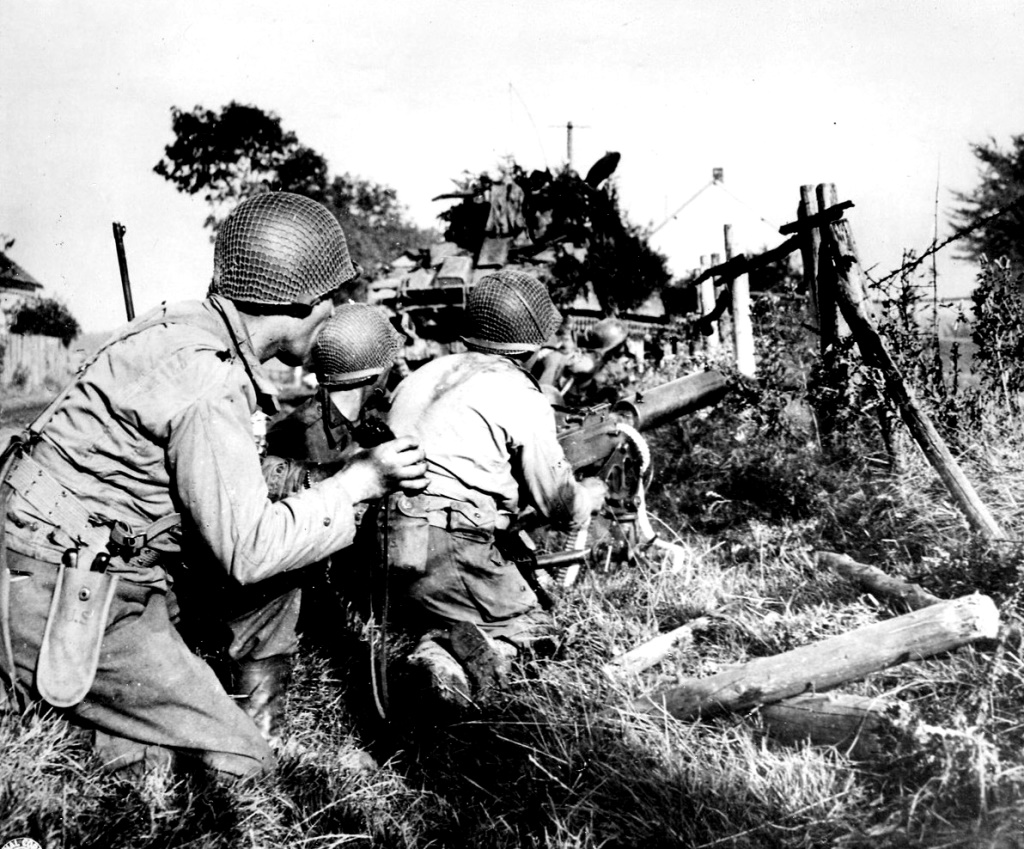During the morning hours of September 17, first, the 48.Grenadier-Regiment and shortly afterward the 89.Grenadier-Regiment detrained in Düren. With these forces the 12.Infantry-Division was supposed to recapture Mausbach and restore a coherent German front from Stolberg to Zweifall. The 89.Grenadier-Regiment received orders to assemble southeast of Eschweiler and to launch its attack via Hastenrath – Scherpenseel toward Werth, the Weissenberg Hill and Diepenlinchen. The mission of the 48.Grenadier-Regiment was to move through Heistern, Venau, and Hamich, and to jump off from Hamich toward Gressenich and Krewinkel, capture Mausbach and reach the Stolberg – Vicht road. According to orders, the 48.Grenadier-Regiment jumped off from Hamich and captured Gressenich, holding it against immediate American counter-attacks from the direction of Schevenhuette. The battalion on the left attacked toward Krewinkel but ran into determined resistance and developed a temporary ammunition shortage so that it was forced to halt its attack. The battalion on the right, driving toward the Mausbach – Diepenlinchen line, had a stroke of unusually good luck.
At a point halfway between Mausbach and Diepenlinchen, it smashed into the flank of an American attack launched from Mausbach apparently in the general direction of Eschweiler. Coming from an unexpected direction the assault took the Americans by surprise. The 48.Grenadier-Regiment was able to knock out 9 US tanks and to capture fifty-seven Americans including one colonel (a regimental commander, according to German sources). But after achieving this success the German attack bogged down just east of Diepenlinchen in the face of tenacious American resistance. The 89.Grenadier-Regiment had meanwhile launched its attack from the Hastenrath – Scherpenseel area. Instead of waiting for only all its forces to assemble there, it jumped off at noon with one battalion in order to meet the threatening American drive on Eschweiler. The battalion pushed south through Werth; in exceedingly bitter fighting it captured the Weissenberg Hill at 1330 then reached the eastern periphery of Diepenlinchen an hour later. There it also encountered such strong American resistance that its attack bogged down.
 In view of the strong American pressure from Krewinkel and probably also the threat to its left flank from Schevenhuette and the Wenau Forest (US 9-ID), the 12.Infantry-Division decided to shift its weight from right to left and to make its main effort through Krewinkel rather than through Diepenlinchen. Permission was asked and granted to call off the attack while the German forces regrouped. By this time the 2.Battalion of the 89.Grenadier-Regiment, additional artillery and antitank forces had arrived on the battlefield. Thus reinforced the Germans resumed their attack at dusk. The main effort drive on the left pushed through the Krewinkel woods into Krewinkel, while on the right the forces pressing south from the Weissenberg Hill and the vicinity of Diepenlinchen penetrated the northern part of Mausbach. This achieved, the 12.Infantry-Division halted for the night.
In view of the strong American pressure from Krewinkel and probably also the threat to its left flank from Schevenhuette and the Wenau Forest (US 9-ID), the 12.Infantry-Division decided to shift its weight from right to left and to make its main effort through Krewinkel rather than through Diepenlinchen. Permission was asked and granted to call off the attack while the German forces regrouped. By this time the 2.Battalion of the 89.Grenadier-Regiment, additional artillery and antitank forces had arrived on the battlefield. Thus reinforced the Germans resumed their attack at dusk. The main effort drive on the left pushed through the Krewinkel woods into Krewinkel, while on the right the forces pressing south from the Weissenberg Hill and the vicinity of Diepenlinchen penetrated the northern part of Mausbach. This achieved, the 12.Infantry-Division halted for the night.
On September 18, the 27.Fusilier-Regiment was to continue its efforts to capture additional bunkers near Muensterbusch, while the 89.Grenadier-Regiment, which had suffered heavy casualties, would regroup and hold its line. The day’s events proved that the 12.Infantry-Division would not find it easy to dislodge the Americans from their salient beyond the Schill Line, once they had recovered from the initial surprise of being hit by unexpectedly formidable German forces, the Americans lost no time before launching powerful, well-supported counter-attacks.
After American artillery had shot the Germans out of Mausbach and Diepenlinchen during the night, two American task forces launched an attack at midnight from the Mausbach area toward Stolberg, while a hail of artillery fire pounded the 1.Battalion of the 48.Grenadier-Regiment east of Mausbach with apparent intent to secure the American right flank. US forces advanced to the southern and southeastern outskirts of Stolberg. They captured the Hammerberg Hill, Burgholzerhof, and the West Wall bunkers along the Vicht River as far as Dinsfeld at 0400 and continued their drive toward the Donnerberg Hill. Another US combat command jumped off toward Stolberg from the Brander Forest and drove as far as the church in Muensterbusch, just west of Stolberg. Perceiving the threatening double envelopment of Stolberg, Col Engel decided not to continue the Mausbach – Krewinkel attack (which no longer looked like an easy thing, anyway) in the morning of September 18, but rather to shift his main effort against the Americans driving on Stolberg. The LXXXI Corps immediately approved his new intentions. As a result, German resistance in the Stolberg area stiffened. Though the Germans were unable to gain more than insignificant ground, they successfully stopped all American attacks.
During the morning, the 27.Fusilier-Regiment repulsed a minor American attack against Verlautenheide, while German artillery hit US positions on the Geisberg Hill. The American drive on the Donnerberg Hill was thrown back with heavy losses; the German counter-attack recaptured two bunkers on the Hammerberg Hill. The Germans in Stolberg also repulsed an American attack against the southern periphery of the town at 1200, but not before some streets of Stolberg had become a battleground for the first time.
 LXXXI Corps to 12.Inf Div at 1500, on Sep 18 1944
LXXXI Corps to 12.Inf Div at 1500, on Sep 18 1944
LXXXI Corps KTB, Kampfverlauf; LXXXI Corps at 1625
on Sep 18 1944, LXXXI Corps KTB, Tagesmeldungen.
Near Diepenlinchen on September 18, American forces badly mauled the 89.Grenadier-Regiment. Its 1.Battalion had orders to attack through Diepenlinchen and penetrate the woods west of that village. Earlier in the morning strong American forces had moved into Diepenlinchen after US artillery had swept the Germans out of there. The 1.Battalion suffered very heavy casualties in the face of the American batteries. After a bitter battle the Germans succeeded in capturing Diepenlinchen again, but under murderous artillery fire their attack bogged down just west of the village. Relentless, American fire reduced the 1.Battalion of the 89.Grenadier-Regiment to one hundred men, about a fifth of its initial combat strength. At 1730, an American counter-attack was able to capture Diepenlinchen once more. An American attack from Schevenhuette toward Gressenich was repulsed.
 LXXXI Corps, at 2100, Sep 18 44
LXXXI Corps, at 2100, Sep 18 44
LXXXI Corps KTB, Tagesmeldungen
A Gp B, at 0200 Sep 19 44. A Gp B KTB, Tagesmeldungen.
According to MSS # A-971 (Engel) and B-816 (Schack) the 2./48.GR launched an attack toward Schevenhuette just before dawn on September 18, and surprised American troops there just as they were being relieved by new forces. Thus the Germans were able to capture Schevenhuette in furious house-to-house and hand-to-hand fighting. By an immediate counter-attack, however, the Americans surrounded the two German companies in Schevenhuette; the Germans dug in but were unable to hold out. After suffering heavy losses, they finally fought their way back to their own lines. By evening Schevenhuette was in American hands again and continued to threaten the flank of 12.ID. The story of this operation has been relegated to this footnote because the writer entertains serious doubt as to whether it ever took place. It seems highly probable that Gen Schack and Col Engel, on whose postwar accounts this story is based, confused it with a very similar operation which definitely took place on Sept 22. The German contemporary documents contain no record of any German operations in Schevenhuette on Sept 18 beyond one solitary hint, in one document, of a later date, which speaks of losses sustained in Schevenhuette on Sept 18. But for this single straw, the writer would have simply dismissed the story as one of many historical inaccuracies to be found in the German postwar accounts and it may well be just that!
In the evening of Sept 18, the 12.Infantry Division front line extended from the southern periphery of Verlautenheide, Hamm, the western edge of Stolberg, the Hammerberg Hill, Niederhof, the Weissenberg Hill and Gressenich. By evening the division had also assembled its fusilier battalion and its engineer battalion. The attack on Diepenlinchen would continue ‘perhaps a regrouping period of twenty-four hours will be required first’. Late in the evening of Sept 18, the Germans outlined their plan for further operations against the Mausbach salient. Since Stolberg was the key to the 12.Infantry-Division operations, all elements of the 9.Panzer-Division would be committed against the American forces which had penetrated the factory areas north and west of Stolberg. After careful recon, the 12.ID engineer battalion would jump off at daybreak on Sept 20 through the woods toward Schevenhuette.
With both flanks (Stolberg and Schevenhuette) thus secured, both battalions of the 89.Grenadier-Regiment were to attack southwestward across Diepenlinchen. The Fusilier Battalion supported by 10 Mark V Panthers would proceed southeast from the Stolberg area and wheel into the West Wall toward Mausbach. Then all forces were to converge and attack along the West Wall (Vicht River) toward Zweifall. On the Aachen front, American forces made no serious attacks toward the city on the 17 and 18 September. Aside from minor attacks at Steinebrueck and Burtscheid, which were repulsed by the 116.Panzer-Division, they contented themselves with an almost ceaseless barrage of artillery fire against German positions in and around the city.
 The scene of American operations against the 116.PD was shifting northward where the US XIX Corps was engaged in its effort to envelop Aachen from the north. The division’s armor situation was improved on September 18 by the addition of 15 assault guns of the 902.Assault-Gun-Brigade. The division also counted a new American jeep among its vehicles because a German prisoner of war had escaped his captors in the stolen jeep. No doubt the man was cock of the walk in his company that day. The events of September 19, similar to many days of fighting on the Western Front, were shaped by the fact that the Germans were in the habit of attacking early in the morning, while the Americans chose the afternoon to launch their operations.
The scene of American operations against the 116.PD was shifting northward where the US XIX Corps was engaged in its effort to envelop Aachen from the north. The division’s armor situation was improved on September 18 by the addition of 15 assault guns of the 902.Assault-Gun-Brigade. The division also counted a new American jeep among its vehicles because a German prisoner of war had escaped his captors in the stolen jeep. No doubt the man was cock of the walk in his company that day. The events of September 19, similar to many days of fighting on the Western Front, were shaped by the fact that the Germans were in the habit of attacking early in the morning, while the Americans chose the afternoon to launch their operations.
The main actions of the day took place in the Stolberg area. At 1100, forces of the 9.Panzer-Division and the 12.Infantry-Division were able to recapture the factory belt west of Stolberg as well as three bunkers on the Hammerberg Hill southeast of that town. Sporadic fighting in the area continued past noon. Shortly thereafter the Americans began the usual very heavy artillery preparation signaling their impending attack. The American operation in the afternoon of September 19 was two-pronged and aimed at an envelopment of Stolberg. On the American, left strong infantry and armor jumped off from a Muensterbusch – Buesbach baseline in a northeasterly direction toward Stolberg. This attack succeeded in recapturing the factory area and in achieving some penetrations in the western part of Stolberg proper. On the American right, other US forces launched their attack from the woods northwest of Mausbach and captured Niederhof, Burgholzerhof and some bunkers on the Hammerberg Hill. In the face of heavy American artillery fire ranging as far as Hastenrath elements of one of the 12.Infantry-Division battalion and 6 Mark V Panthers launched a flanking counter-attack from the woods southwest of Hastenrath and drove down the road via Hochwegerhof toward Niederhof.
 LXXXI Corps to the 12.Inf Div at 1800 and 2010 on Sep 19 44
LXXXI Corps to the 12.Inf Div at 1800 and 2010 on Sep 19 44
LXXXI Corps KTB, Kampfverlauf. LXXXI Corps, at 2215 on Sep 19 44
LXXXI Corps KTB, Tagesmeldungen.
 This counter-attack apparently was less than successful, for during the night American troops supported by 5 tanks were able to extend their gains northeastward when they captured Hochwegerhof (about one mile north of Diepenlinchen) at 0200 on September 20. West of Stolberg, on the other hand, the see-saw battle continued late in the evening of September 19, and German troops managed to retake three bunkers. Two of these were located near the railroad running along the southeastern edge of the Würselen Forest (just east of Hamm and Kohlbusch) while the third was at the western end of that forest. The Aachen sector was rather quiet on September 19. Early in the morning, the 116.Panzer-Division reported increased American recon activity northwest of Rothe Erde, but aside from that the American artillery limited themselves to harassing fire against the German MLR and rear areas for the remainder of the day.
This counter-attack apparently was less than successful, for during the night American troops supported by 5 tanks were able to extend their gains northeastward when they captured Hochwegerhof (about one mile north of Diepenlinchen) at 0200 on September 20. West of Stolberg, on the other hand, the see-saw battle continued late in the evening of September 19, and German troops managed to retake three bunkers. Two of these were located near the railroad running along the southeastern edge of the Würselen Forest (just east of Hamm and Kohlbusch) while the third was at the western end of that forest. The Aachen sector was rather quiet on September 19. Early in the morning, the 116.Panzer-Division reported increased American recon activity northwest of Rothe Erde, but aside from that the American artillery limited themselves to harassing fire against the German MLR and rear areas for the remainder of the day.
All day, on September 19, the fate of the 12.Infantry-Division counter-attack, planned for the morrow, hung in the balance. For one thing, the division faced a serious ammunition shortage. Delivery of at least 6100 rounds of 105-MM ammunition was essential before the division could carry out its projected attack. Since the LXXXI Corps was unable to supply this ammunition, it turned to the 7.Army for help. The army transport officer reported that an ammunition supply train was expected at Düren during the night from the 19 to 20 September, but that its content was unknown.
 LXXXI Corps to 12.Inf Div at 0200 on Sep 19 44
LXXXI Corps to 12.Inf Div at 0200 on Sep 19 44
7.Army to LXXXI Corps at 0310 and 0400 on Sep 19 44
LXXXI Corps KTB, Kampfverlauf (It is not clear whether or not this train eventually helped to ease the shortage, since the attack was called off, anyway, and the reasons are complex, involving, among other factors, a change in command at the corps command level).
To complicate matters further, the 9.PD, whose forces were needed to help restore the situation around Eilendorf, was short of fuel. Nevertheless, in the evening of September 19, plans still called for the 12.ID to go ahead with its attack, although Gen Schack remarked that the attack by the 12.ID tomorrow morning will have little success. In addition to its other problems the 12.ID already faced a personnel shortage. On the morning of September 20, Col Engel oriented his new corps commander, Gen Friedrich J. M. Koechling about the situation. In stressing the gravity of his situation, Col Engel stated that only 400 men of the 89.Grenadier-Regiment were still available for the defense of the sector east of Stolberg. One engineer company of the 12.ID, intended to close the gap near Duffenter (American salient at Hochwegerhof) had not arrived and its whereabouts were still unknown.
 On September 20 1944, Gen Schack was relieved as commander of the LXXXI Corps (in connection with the Schwerin affair) and was replaced by Gen Koechling. Gen Koechling to Col Engel at 0700 on Sep 20 44, LXXII Corps KTB, Kampfverlauf.
On September 20 1944, Gen Schack was relieved as commander of the LXXXI Corps (in connection with the Schwerin affair) and was replaced by Gen Koechling. Gen Koechling to Col Engel at 0700 on Sep 20 44, LXXII Corps KTB, Kampfverlauf.
























